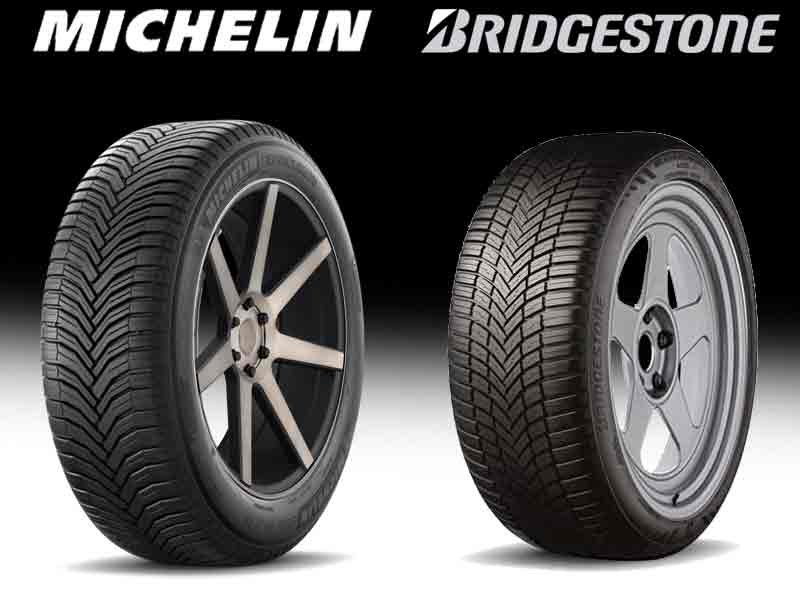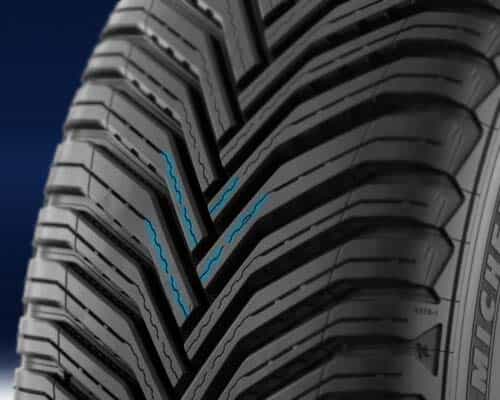Bridgestone Weather Control A005 EVO vs Michelin CrossClimate 2: The Bridgestone Weather Control A005 and the Michelin CrossClimate 2 are two remarkable all-weather tire options. With their individual promise of premium handling in various climatic conditions, the decision to choose one can be quite challenging. Let’s examine each one closely.
But first, let’s talk about where these tires should improve.

Examine the treads on these tires closely. They hold the key to knowing which to choose. In fact if you visit my "tread design" page, picking the right tire would never bother you.
- Bridgestone WeatherControl A005 EVO could improve its performance in winter traction, dry directional grip, and on-road vibration absorption.
- Michelin CrossClimate 2 could enhance its performance in noise generation and overall wet handling.
And so this brings us to the test scores, they achieved in our testing.
Table of Contents
Test Scores – Out of 10
| Weather Control | Crossclimate 2 | |
| Dry Traction | 9 (Better) | 8 |
| Wet Traction | 9 (Better) | 8 |
| Snow Traction | 8 | 9 (Better) |
| Ice Traction | 8 | 9 (Better) |
| Fuel Efficiency | 8 | 8 |
| Noise | 9 (Better) | 8 |
| Ride Comfort | 8 | 9 (Better) |
Design Comparison
The Michelin Crossclimate 2’s tread design stands out with its shoulder blocks possessing wider block valleys, enhancing road grip through embedded lateral slits.

Despite the fact that they don’t maximize road contact, these blocks still ensure exceptional traction.
Moreover, separated from the central tread area by longitudinal slits, these shoulder blocks ensure a strong grip in both lateral and circumferential directions.
On the other side, Bridgestone Weather Control A005 EVO also features a directional tread pattern.

But unlike the Crossclimate 2, the tire is more voided up.
You can see its lugs are separated by longitudinal slits (of multiple angles), at different places.
So each swooping lug is divided up in to 3 parts.
So this tire also make 6 total circumferential ribs, allowing for better snow traction, and resistance to hydroplaning.
Moreover, the tire is equipped with more sipes, though all of them are rectilinear and not wave like, as seen on the Crossclimate 2 tire’s central most area.
(It’s important because interlocking sipes do better, when it comes to wet traction).
Dry Traction and Handling
The dry (directional) grip depends on how well the rubber contacts the ground (form its middle tread part), whereas shoulders decide handling.
That’s why its obvious why, with shorter braking distances (seen on average), the Michelin CrossClimate 2’s performance in dry directional grip is superior, thanks to its rounded contact patch, and interlocking central (more closed up) lugs.
The Bridgestone Weather Control, on the other hand, has central blocks, which unfortunately, do not interlock, and have more voids in them.
But the tire still offers superior dry lateral traction with its stiffer rubber composition.
Basically, its tread lugs facilitates a smoother weight transition from the center to the sides, thereby providing the tire with more direct and responsive steering feedback.
Winter Traction
The Michelin CrossClimate 2 demonstrates a significant enhancement in winter traction performance compared to its predecessor, and compared to other premium all-season options currently available, it ranks among the best.
So it’s not surprising to see this tire offering superior gripping and cornering, compared to Weather Control EVO, where it’s commendable performance can be attributed to two primary factors.
- Firstly, it facilitates better “snow-to-snow contact” with the ground, a critical feature given that snow adheres more effectively to snow than to rubber.
- Secondly, its design incorporates more efficient, swooping arms which excel in shoveling snow, thereby propelling the vehicle forward more effectively.
Conversely, the Bridgestone Weather Control lacks with its more voided up design, not offering as much snow paddling abilities, even though both tires are 3-peak mountain snowflake rated.
Noise Generation
The primary contributor to noise is the interaction of air particles with the tire tread, causing a phenomenon known as in-groove resonance.
And here, this penetration of air mainly occurs through the sides or shoulder voids of the tread.
That’s why it makes sense why the Bridgestone WeatherControl demonstrates a superior performance, with its narrower shoulder gaps, facilitating a lower degree of air passage.
Moreover, the tire’s new gen compound also allows for less overall deflection of air particles, so they aren’t generating as much in-groove resonance from echoing as well.
Nevertheless, the discrepancy in noise levels between the two tires is minimal, primarily due to the CrossClimate’s rounded footprint and streamlined blocks, which efficiently direct most air particles out without any collision with the inner walls.
But still, if you have to pick one here, go with Bridgestone.
Wet Traction Efficacy
The proficiency of a tire’s traction on damp surfaces predominantly relies on two key elements: the quantity of sipes and the composition of the tire rubber.
Sipes function by absorbing water particles within their slits. And given that flexibility is also required for this absorption process, the overall efficiency of water extraction is also influenced by the tread compound.
Now both tires here are pretty great, but upon further examination through testing, the Michelin CrossClimate 2 showed superior directional grip, while the Bridgestone demonstrated enhanced overall wet handling and resistance to hydroplaning.
Directional grip depends on central lugs, and CrossClimate 2, with its rounded contact patch and interlocking central siping, offers superior stopping power.
Whereas, the Bridgestone Weather Control A005 EVO, having more biters on the shoulders, affords better handling.
Moreover, its more voided structure facilitates rapid water evacuation via the grooves, thereby enabling the tire to attain higher float speeds during both straight and curved water tests.
(Float speeds tell how fast a tire can roll over standing water, and its the direct way to measure resistance to hydro or aquaplaning).
On-Road Vibrations
The capacity of a tire to mitigate vibrations is intrinsically linked to its ability to handle road bumps, a characteristic heavily influenced by the tire’s internal and external materials.
In other words, tires manufactured from softer compounds typically provide a smoother ride, with the Crossclimate 2 serving as a prime example.
It features a thermally adaptive softer rubber top that not only delivers excellent snow traction but also effectively absorbs the irregularities and roughness of the road surface.
The Bridgestone Weather Control, on the other hand, although offers superior steering response with its stiffer built, has to compromise a little when it comes to impact comfort.
Summary
Bridgestone WeatherControl A005 EVO excels in:
- Noise Generation, due to its narrower shoulder gaps, which reduces air passage.
- Wet Handling and Hydroplaning Resistance, due to its more voided structure and greater number of biters on the shoulders.
- Dry Lateral Traction, with its stiffer rubber composition and more voided central blocks.
Michelin CrossClimate 2 excels in:
- Wet Directional Grip, with its rounded contact patch and interlocking central siping.
- Winter Traction, due to its effective “snow-to-snow contact” and more efficient, swooping arms design.
- Dry Directional Grip, with its rounded contact patch and more closed-up central lugs.
- On-Road Vibrations, with its softer rubber top.
